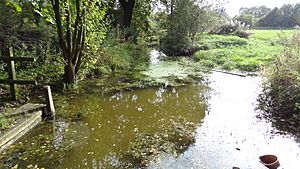Cranham Marsh facts for kids
Quick facts for kids Cranham Marsh |
|
|---|---|
 |
|
| Type | Local Nature Reserve |
| Location | Cranham, London Borough of Havering |
| OS grid | TQ 567 856 |
| Area | 15.3 hectares |
| Managed by | Essex Wildlife Trust |
Cranham Marsh is a special natural area in Cranham, part of the London Borough of Havering. It's a big place, about 15.3 hectares, which is like 30 football fields! This amazing spot is known as a Local Nature Reserve, meaning it's protected because of its important wildlife and plants. It's also recognized as a "Site of Metropolitan Importance for Nature Conservation," which means it's super important for nature in the whole London area.
The local council, Havering Council, owns Cranham Marsh. But it's looked after by a group called the Essex Wildlife Trust. They work hard to keep the marsh a safe home for all its plants and animals.
Contents
Exploring Cranham Marsh's Habitats
Cranham Marsh is home to many different types of natural environments, called habitats. These include peaceful woodlands, damp wet meadows, and squishy marshlands. It even has one of the few remaining areas of "fen" in the region. A fen is a type of wetland that gets its water from groundwater, making it very special.
Woodland Wonders
Within Cranham Marsh, you'll find three small woods. One of these is called Spring Wood. This wood is very old, meaning it has been a woodland for hundreds of years. Because of its age, it has special types of trees and plants that only grow in ancient woodlands.
Wetland Plants
The wet areas of Cranham Marsh are home to some plants that are not often seen elsewhere. These include the beautiful southern marsh-orchid, which has lovely purple flowers. You might also spot fine-leaved water-dropwort and golden dock, which are rare plants in this area.
Amazing Animals and Insects
Cranham Marsh is a busy place for wildlife. It's a great spot to see water voles, which are small, furry creatures that live near water.
The marsh is also a paradise for insects. A very rare type of bee, called Macropis europaea, lives here. Scientists have also counted 23 different kinds of butterflies fluttering around the marsh.
The River's Connection
A small stream, which is a branch of the River Ingrebourne, flows right through Cranham Marsh. This stream helps to keep the marsh wet and healthy, providing water for all the plants and animals that live there.
Visiting Cranham Marsh
If you want to explore Cranham Marsh, you can get there by walking along footpaths. These paths can be found from Park Drive and The Chase. It's a wonderful place to visit and learn about nature.

